Text Resize
buttons

|
Note
The subject 1938 dated Finnish 7.65mm ammunition box has been part of the Land of Borchardt collection for several years and is discussed and pictured in the article below under the section on AMMUNITION. Pictures of the subject Finnish ammunition box were generously provided to G. Sturgess for inclusion in his book "Pistole Parabellum" by Görtz/Sturgess1 and is pictured in Volume III on page 1702, Military 7.65mm Ammunition made in Finland, Figure 1732. The ammunition is incorrectly attributed to the G. Sturgess collection as defined by the authors’ statement in the book "A Note on the Illustrations", but are actually part of the Land of Borchardt collection.
Background
In the early1920s, 1922 to be specific, the Finnish military purchased under contract, several thousand DWM/BKIW 30 caliber, 98mm barreled commercial Lugers, designated in 1923 by the Finnish military as the Pistooli model 23 or m/23 (Parabellum). Orders to complete the contract continued throughout the 1920s into the 29 DWM s suffix range with final deliveries in 1929. The serial numbers were numbered in the commercial 4-digit letter suffix style. They are distinguished by an SA or Suomen Armeija, Finnish Army property mark in a rectangular cartouche stamped on the left forward side of the receiver, applied in the 1940s, next to the DWM/BKIW factory vertical crown N commercial proof. Many of the m/23 pistols had a 25mm diameter brass, unit ID disc, recess or flush fitted to a circular cut-out in the right side walnut grip, secured by two screws or rivets by the Finnish military, however very few m/23 Pistooli survive with the disc as it was removed prior to sale as surplus, mostly in the 1980s. In fact very few m/23 Lugers survive with the original wooden grips, the original 30 Cal barrel, nor the original DWM/BKIW factory Rust Blue finish as due to their heavy use and harsh environment. Many of the m/23 Pistooli were fitted with Tikkakoski1 4",4-¾" or 5" 9mm replacement barrels, with the 4" (100mm) 9mm barrels less encountered. Many of the original wooden grips were also changed out to black Bakelite grips, made by the Finnish and the entire gun was hot dip reblued.
The manuals
It is not certain that the Finnish military published an m/23 (Parabellum) instruction manual, totally dedicated to the m/23 pistol and, if there is such a publication, it has not surfaced. What the army did publish are several documents or handbooks throughout the service life, covering the DWM/BKIW m/23 and the Finnish manufactured Lahti L-35. These handbooks covered such things such as operating, handling and shooting instructions. These handbooks are the primary subject of this article.
Featured herein are four original Finnish military documents with the first being dated 1938. The 1938, 187 page hardbound cover, Finnish text handbook is entitled: Sotamiehen Kirja or The War's Book. The handbook has several photos and drawings showing the weapons in use at the time of the "Winter War" including three pages on the 30 caliber, 4 inch barrel m/23 Pistooli "Parabellum" with about a page of descriptive text and one line drawing picture collage identifying 15 or almost all of the parts.
Even though by 1938 the 1935 Finnish designed and manufactured 9mm Lahti L-35 pistol was the official pistol of the Finnish armed forces, they were not yet in service when the subject 1938 handbook was printed, as there is no picture or mention of the L-35 Lahti pistol in the body of the text nor in the table of contents.
First ordered in 1936, the L-35 pistol suffered from production delays and only about 100 examples were delivered before the beginning of World War II. The war greatly motivated those responsible for production and by February 1940, more than 1000 had been delivered. When the "Continuation War" began in 1941, 2500 pistols had been produced. A further 3000 were made before production ended in December, 1945. In early 1950 the government factory decided to assemble a few hundred Lahti pistols from parts manufactured during wartime and made more than 2000 brand new guns, selling all on the civilian market. The line was again closed in the early Fifties, though spare parts continued to be made until 1979. In 1985 the factory made a special anniversary edition of 100 Lahti pistols. The total Finnish production was about 9000 examples.2
A 1941 published Finnish military handbook featured herein, entitled SOTAMIEHEN TASKUKIRJA or War Pocket book was considered to be a recommended pocket primer on all rules regulations, and refresher on training subjects. These handbooks were recommended to all Finnish soldiers, especially new recruits, who carried these handbooks. In the handbook are three pages dedicated to the m/23. A most unusual use of an old model dish toggle knob, 120 mm 30 cal barrel Luger drawing is shown on page 67 to describe the original 30 cal m/23 Luger and its component parts in general. The next page, 68, uses a line drawing of the P.08, yet specifically identified as the m/23, as by 1941, a 9mm conversion pistol designated the m/08, to describe and identify the component parts. Interestingly as of 1941 there is no mention in this handbook of the L35 Lahti pistol.
The 30 Cal m/23 "Parabellum" and 9mm m/08 was still in extensive service into the 1960s as evidenced by two 1960s Finnish documents, a 1961 published, rather voluminous, 450 page handbook entitled: nykyajasn reserving Upseeri ja Aliupseeri or present-day reserve officers and NCOs and a 1963 published, 324 page Finnish small arms handbook entitled: Kevyiden Aseiden Kasittely ja Ampumakoulusopas, loosely translated to: "Light Weapons Handling and Shooting Training Guide" showing the Finnish 7.65 DWM/BKIW m/23 Pistooli and the Lahti 9mm M/35. The 1961 featured handbook is, most likely, a commercial publication for the Finnish military, based on the commercial advertising pictured in the handbook, from milk to cars to bank ads.
There are other similar period Finnish published military small arms handbooks, an example being a 1958 printing. The 1961 hand book covers the m/23 and L-35 on three pages, page 68, page 69 and page 70. The picture or actual photograph layout of both the 1961 and 1963 handbooks show the m/23 as a rig, which is different from the 1938 handbook which shows only the m/23 as a line drawing. The m/23 rig in the post war handbooks includes the holster used with the board stock, a cleaning rod, magazine and the m/23, broken down to four basic parts, identified by numbers in the text caption description as the main elements.
The holster or pistoolikotelo, in Finnish, is not identified with a number. The text caption names the six numbered components of the m/23.
It is, however, the 1963 printing that must be a special edition or library copy as the gray cover title text is in gold lettering and the inside title page has two circular blue ink stamped entries. The upper stamp text of "Lapin Lennosto" translates to "Lapland Air Command" and the lower stamp text of "Hameen Lennostro" translates to "Häme Wing" renamed the Lapland Wing in 1974. One can assume the manual was the property of the Lapland Air Command.
Ammunition
Also in the 1963 handbook is a page picturing and describing the ammunition used for the m/23 and m/35. Note the various indigenous head stamp markings. There are surviving 30 Cal Finnish military and commercial 50 round packaged ammunition. Interestingly a 1938 dated Finnish 50 round, 7.65 commercial box is similarly packaged and labeled to other period 1930s German commercial 30 Cal packaging. Also interesting to note is that the Finnish are still manufacturing, packaging and selling "7.65 Parabellum .30 Luger" ammunition to the public. Also pictured are two 1940s dated Finnish 50 round, 9mm ammunition boxes, dated 1942 and dated 1944.
 M/23 Pistooli (Parabellum) M/23 Pistooli (Parabellum) 
Pictured below is a classic or typical m/23 late 1920s BKIW contract Finnish Luger rework, serial number 3629s with a 4" 9mm Tikkakoski logo stamped barrel replacement, yet retaining original unnumbered BKIW factory wooden grips, although not necessarily original to this gun, with the right side circular brass unit ID disc insert removed. The circular recess cut into the right side wooden grip has two unidentified, hand cut characters. The DWM frame appears to have a hot dip immersion blue refinish. The frame is export marked on the underside edge of the right side frame rail; TGI KNOX TN 9MM P08 GERMANY.
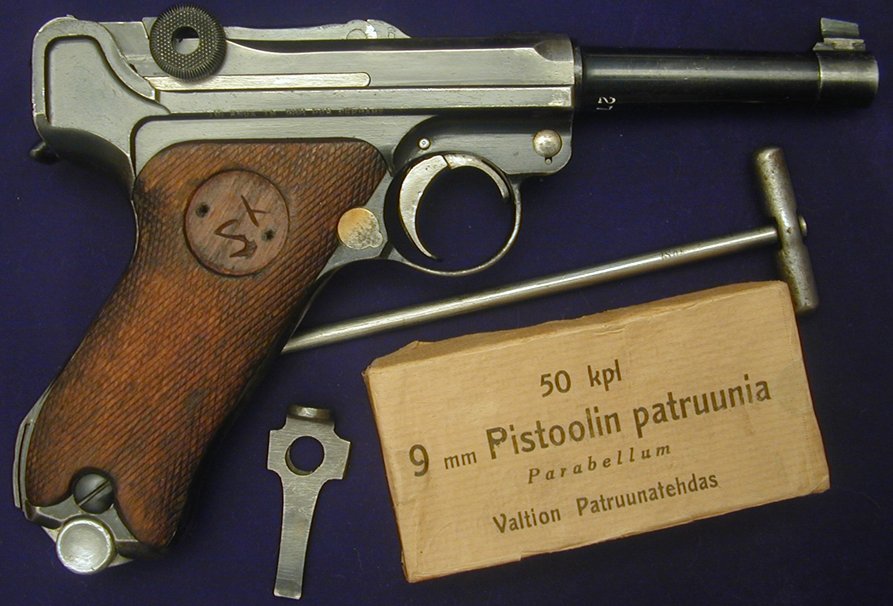
Typical m/23 late 1920s BKIW contract Finnish Luger rework, serial number 3629s.
The gun is a mix of different parts and serial numbers with the entire original DWM logo toggle link assembly being replaced with a WW1 Erfurt assembly. Only the Erfurt breechblock and middle link serial numbers are matched, while the rear toggle link, per the underside factory inspection mark, is of Mauser manufacture with no serial number whatsoever. However, the original rear V notch sight block was U notched to correspond with the rather wide, untapered barrel front sight blade. Behind and in the modified rear link sight notch is a patch of red paint.
There is a 2mm diameter hole drilled in the forward end underside of the replacement Erfurt breechblock to the firing pin chamber. The purpose of this hole is unknown, possibly to relieve increased pressure in conjunction with the barrel change from 7.65mm to 9mm and the 1934 or later manufactured three-grooved replacement firing pin, and partly, due to the sub-zero cold environment. It is certain, however, that the added breechblock hole is not spurious, as it has been observed on several Finnish m/23 modified breechblocks, DWM and Erfurt with 9mm and 30 Cal barrel replacements. It is not certain whether the hole was added to the breechblock of the original delivered m/23 30 Cal pistols or just the 1940s Tikkakoski 30 Cal and 9mm barrel replacements. The subject m/23, 29 DWM or BKIW frame serial number is 3629s, but the 4 inch Tikkakoski replacement barrel is serial number stamped 2719 in large 4mm high numbers, possibly indicating an additional barrel change. To complete the mismatch ensemble, the magazine is an aluminum bottom replacement, serial number 3906h, Stick Wing Eagle 63, + stamped Mauser spare with an unusual, unidentified TK6 stamped on the flat magazine body spine which in Finnish the K could mean (T) Komppania, gun # 6.
Regarding the magazines supplied with the original 1920s contract Finnish Lugers, the construction would have been a sheet metal crimped magazine body with a wooden bottom. That is what was available during the early 1920s, and is also shown in the large 43 inch x 31 inch format „PARABELLUM"-PISTOOLI 23 Finnish/Swedish language wall chart. However, the m/23 rigs pictured in the 1961 and 1963 handbooks show a blued sheet metal crimped magazine body with an unmarked aluminum bottom. This suggests that, as a minimum, seeing that aluminum bottom magazines were not available until 1928, at least to the German army, that the m/23 figures used in the 1961 and 1963 handbooks were no earlier than 1928 and possibly later as it is not known when the blued magazine body was introduced. Another possibility is that since the Finnish contract was delivered in small quantities throughout the 1920s, with the last deliveries in 1928, could account for the later deliveries with aluminum bottom magazines.
The configuration and condition of this gun fits the general description of any m/23- m/08 that saw service in the Winter War and the Continuation War. Many of these guns were later put together from parts and exported to the United States in the post war years, until current times as evidenced by the subject m/23, which is a parts mix of four manufactures, DWM/BKIW, Mauser, Erfurt and Tikkakoski and is believed to have been exported to this country as late as 2009.
The Holster
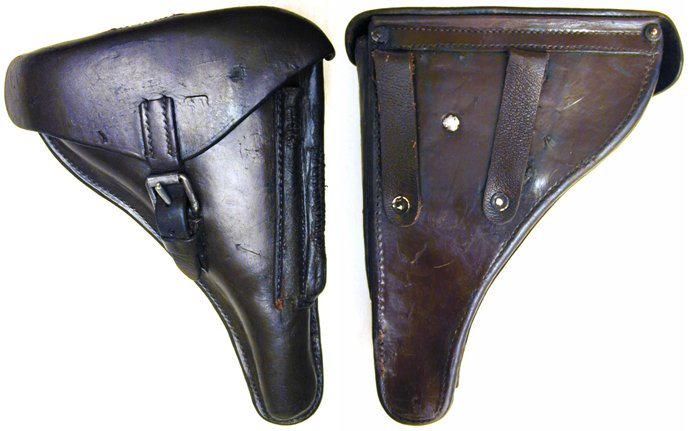
Dark brown Finnish military issue WW2 Lahti Holster.
Pictured above is a dark brown Finnish military issue WW2 Lahti Holster as indicated by the large rectangular shape loading tool leather pouch under the flap, large belt buckle and on the rear by the two reinforcing rivets used in conjunction with stitching to secure the holster flap to the holster body and the method of securing the lower end of the belt loops to the holster back side, by using two rivets along with a third, rivet in between to secure the lower end of the "pull-up" leather strap. The Holster is in much used condition with some wear to the leather and there was some wartime stitching repair done to the spare magazine holder. These repairs are common on Finnish army holsters. There is an SA Finnish army property stamp in cartouche on the flap of the holster. This holster would also be the right size for use with the Finnish replacement 9mm 4" and 4-¾" long barrel Lugers as the Finnish army has also used these holsters with these pistols since they slightly larger than the m/23 military holsters.
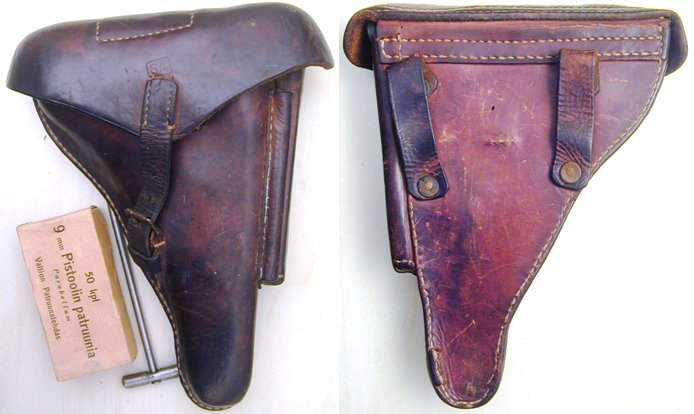
SA property stamped, brown holster, made specifically for the m/23 Pistooli.
Pictured above is a modified brown holster, made specifically for the m/23 Pistooli with a SA property stamp. The overall holster size is slightly smaller than the Lahti L/35 holster and is assembled differently with shorter twin belt loops and with the pull-up strap secured to the holster backing by stitching vs. the rivet used on the m/35 holster. The m/23 holster also lacks the two end reinforcing rivets on the holster flap-to-body leather hinge strip. This holster was originally issued to be used with the Finnish SA stamped board/stock as there is an extra layer of leather sewn to the lower body spine about the width of the leather strap, used to secure the board stock to the holster toe and on the other side of the toe can be seen the other end or edge of the strap, sandwiched or wafered between the holster backing and the front of the holster, which has been deliberately cut flush to the holster body.
Regarding the subject modified m/23 holster, the original holster had an unusual belt loop/stock configuration, consisting of two horizontal leather straps attached to the upper holster backing with four rivets. Attached to the two horizontal straps were two vertical belt loop straps, also attached by rivets, making a cradle for the upper wider part of the board stock. The holster/stock arrangement worked using gravity as while the rig was attached to the soldier’s belt, the stock could be removed simply by lifting it out of the holster belt loop cradle and the lower toe strap. The pistol could then be removed from the holster, still attached to the soldier’s belt, and attached to the board stock iron. The m/23 was, according to published information, issued with a holster/board stock, but not many have been found and were, apparently discarded, requiring the subsequent removal the holster securing strap. The m/23 holster with the strap affixed to the holster toe can be seen, front view only, pictured in the Finnish handbooks, featured herein.
The modification of the upper horizontal and vertical strap configuration described above was accomplished to the subject m/23 holster in the following manner: The belt loop straps as currently located are rather far apart on the holster because in order to convert the holster from a board stock configuration without adding extra holes to the holster backing, the two horizontal leather straps, which were attached to the upper holster back, along with the two vertical belt loops, were removed and then separated from each other. The horizontal straps were discarded while to the vertical belt loops were retained and as stated, not wanting the make additional holes, were reattached to the holster back directly, using the existing upper and lower horizontal leather strap holes. Apparently some difficulty was encountered reattaching the upper left leather belt loop to the subject holster body as the belt loop rivet is attached through the holster on the backside in a normal manner, yet inside the holster secured with what appears to be field or depot repair, a pan head, slotted screw. The only difference in the pictured original m/23 holster is the presence of a rivet used to retain the lower termination of the pull-up strap to the holster backing whereas with the modified holster there is no rivet and stitching is used, which can be attributed, simply to a different holster manufacturer.
Seeing the difficulty of attaching the board/stock to the m/23 in the field, possibly under severe winter conditions, being a two step process, requiring setting aside the pistol or the board stock, whichever was withdrawn first, while the other was withdrawn, then attaching the board stock attaching iron to the m/23 attaching lug would be a bit cumbersome. It is not hard, therefore, to imagine in those circumstances that many holsters were, possibly depot converted, hence the subject rarity of any surviving Finnish army SA stamped board stocks and especially board stock/holster rigs.
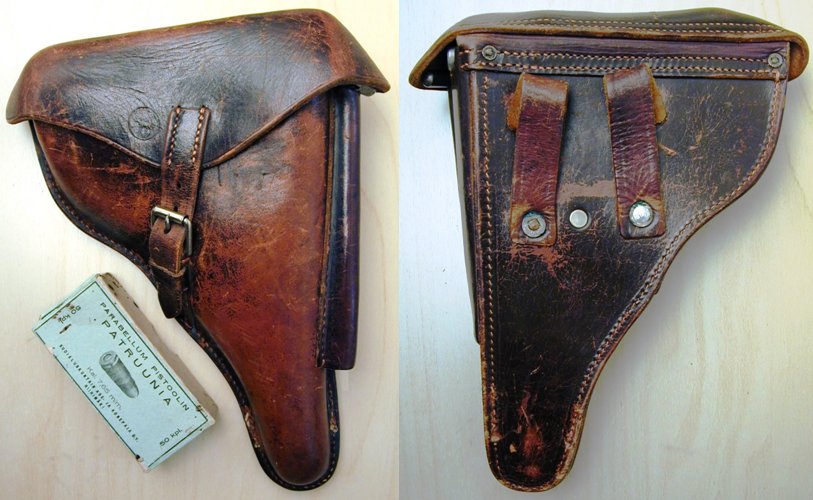
1920s brown leather, Finnish commercial holster for a .30 Cal Luger.
Also pictured are two 1920s brown leather, Finnish commercial holsters for a .30 Cal Luger. The first holster has a retailers' Elk in circle (OULU) trademark on top flap and is pictured with an inserted magazine and cleaning rod. The first holster could have been used by the Finnish army, despite lacking the SA mark, based on the two reinforcing rivets used in conjunction with stitching to secure the holster flap to the holster body and the method of securing the lower end of the belt loops to the holster back side, by using two rivets along with a third, centered rivet to secure the lower end of the "pull-up" leather strap, which is similar to the Lahti L-35 military issue holster, but not the m/23 military issue holster. Oulu is the capital of Oulu province, west central Finland, at the mouth of the Oulu River on the Gulf of Bothnia.
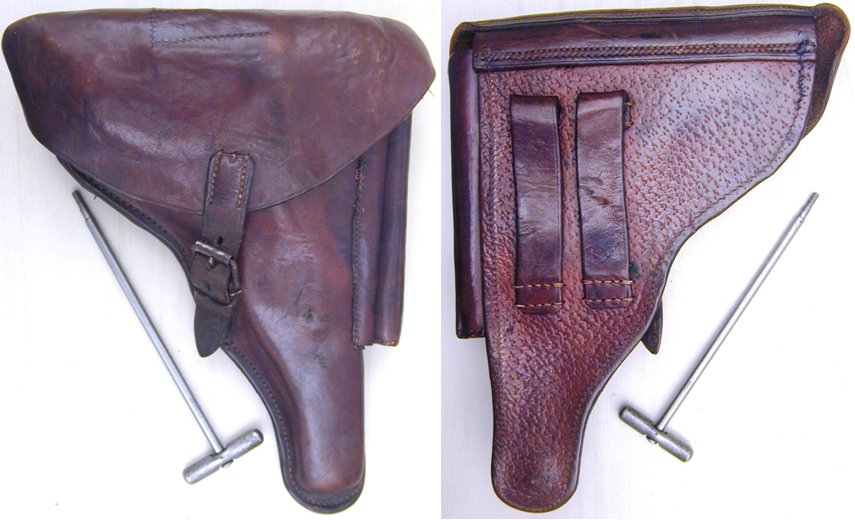
1920s brown leather, Finnish commercial holster for a .30 Cal Luger.
The second Finnish commercial holster has no makers mark but with a similar military holster style square edge pattern leather loading tool pouch under the flap, yet the holster construction is configured differently, without using any reinforcing rivets and the leather back side is unusual as it features a unique "Pebble grain" finish.
Also pictured is a three-piece Finnish cleaning rod with a close-up of the SA marks and one other peculiar SA stamped Finnish cleaning rod.
| |





 Home page
Article created: Friday, October 31, 2008
Home page
Article created: Friday, October 31, 2008
